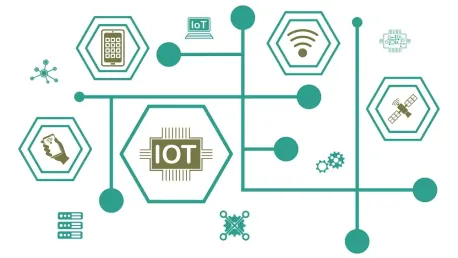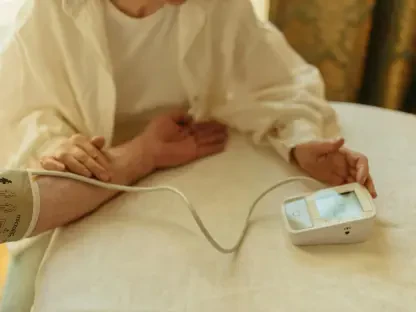The Internet of Things (IoT) is set to transform the healthcare industry dramatically by 2032. IoT in healthcare refers to a network of internet-enabled devices that collect and exchange data to enhance medical services and patient care. This technological revolution promises to streamline healthcare delivery, improve patient outcomes, and promote operational efficiency across medical facilities. As we delve deeper into this transformation, it becomes clear that IoT’s impact will be profound and multifaceted, affecting nearly every aspect of healthcare.
The Growing Market for IoT in Healthcare
As the healthcare industry increasingly embraces IoT, the market is experiencing rapid growth. According to Polaris Market Research, the IoT in healthcare market was valued at USD 128.18 billion in 2023 and is projected to reach USD 556.71 billion by 2032, with a compound annual growth rate (CAGR) of 17.9%. This surge highlights the immense potential and expanding role of IoT technologies in the healthcare sector. Several factors are driving this growth, including the rising prevalence of chronic diseases, the increasing elderly population, and the surge in digital technology adoption. Additionally, healthcare providers are recognizing the value of IoT in improving patient care, reducing costs, and enhancing operational efficiency.
The expansion of this market is not just about numbers; it’s about the capabilities that IoT brings to the table. The technology significantly simplifies complex healthcare processes, allowing for seamless data sharing, which in turn leads to more accurate diagnostics and personalized treatment plans. As more healthcare facilities integrate IoT systems, the demand for these advanced solutions is only expected to increase. This transformative trend shows the healthcare industry’s shift towards a more data-driven and patient-centric approach.
Technological Integration and Innovations
The integration of various IoT devices into healthcare systems is at the forefront of this technological revolution. Wearable devices such as smartwatches and fitness trackers, along with implanted medical devices, play a crucial role in real-time health monitoring. These devices can continuously track vital metrics like heart rate, blood pressure, and body temperature, providing valuable data to healthcare providers. This innovation is not only beneficial for patient wellness but also for clinicians who can monitor patient health remotely and make adjustments as needed.
Remote patient monitoring (RTM) is another critical application of IoT. RTM allows healthcare professionals to collect patient data remotely, enabling timely interventions and personalized treatment plans. This not only enhances patient care but also reduces the need for frequent hospital visits, thus alleviating the burden on healthcare facilities. Moreover, the data collected through RTM can be used for predictive analytics, helping healthcare providers anticipate and prevent adverse health events before they occur. This proactive approach to healthcare is one of the most promising aspects of IoT integration.
Enhancing Patient Care Through Remote Monitoring
Remote patient care is emerging as a significant trend in the IoT healthcare revolution. With the help of IoT devices, patients can be monitored in their homes, reducing the need for prolonged hospital stays. These devices automatically collect and transmit patient data, allowing healthcare providers to track health conditions and make informed treatment decisions remotely. This model is particularly beneficial for managing chronic conditions like diabetes or hypertension, where ongoing monitoring is essential for effective management.
For example, patients with chronic diseases like diabetes or heart conditions can use IoT devices to monitor their health metrics in real-time. Any abnormalities or deviations from normal ranges trigger alerts, prompting healthcare professionals to take immediate action. This proactive approach significantly enhances patient care and outcomes. Furthermore, the convenience of remote monitoring improves patient compliance with treatment plans, as they no longer need to frequently visit healthcare facilities for routine check-ups. This not only improves patient satisfaction but also makes the healthcare system more efficient.
Government Investment and Support
Governments worldwide are investing heavily to facilitate the adoption of IoT in healthcare. These investments aim to enhance technological capabilities, provide better access to remote healthcare services, and ultimately improve patient outcomes. Government support plays a vital role in accelerating the deployment of IoT solutions across healthcare systems. By funding research and development initiatives, governments are helping to push the boundaries of what’s possible with IoT technology in healthcare.
In many countries, initiatives are being launched to incorporate IoT into national healthcare strategies. This includes the development of telemedicine platforms, electronic health records (EHR) systems, and other digital health solutions. Such initiatives not only foster innovation but also ensure that healthcare services are accessible to a broader population. By standardizing these technologies and making them part of the national healthcare framework, governments are ensuring that all citizens benefit from the advancements in IoT and digital health. This widespread adoption is crucial for the long-term success and sustainability of IoT in healthcare.
The Role of Artificial Intelligence (AI) in IoT Healthcare
The convergence of artificial intelligence (AI) with IoT is a game-changer for the healthcare industry. IoT devices equipped with AI capabilities offer advanced solutions that enhance data accuracy, predictive analytics, and operational efficiency. AI algorithms can analyze vast amounts of data generated by IoT devices, providing actionable insights to healthcare providers. This combination of technologies goes beyond simple data collection; it enables a deeper understanding of patient health and more effective interventions.
AI-powered IoT devices streamline healthcare processes by automating workflows, optimizing resource utilization, and enabling predictive maintenance of medical equipment. Additionally, AI enhances diagnostic accuracy, allowing for early detection and intervention of medical conditions. This integration of AI and IoT is set to revolutionize healthcare delivery and patient outcomes. Predictive analytics can help identify trends and potential health risks long before they become critical, allowing for earlier and more effective treatment. This not only improves patient outcomes but also reduces healthcare costs by preventing expensive emergency interventions.
Addressing Challenges and Barriers
Despite the promising potential of IoT in healthcare, several challenges need to be addressed for widespread adoption. One significant barrier is poor internet accessibility, particularly in underdeveloped regions and areas with low literacy rates. Limited internet connectivity hinders the implementation of IoT solutions, affecting the overall expansion of the market. Without reliable internet access, the benefits of IoT cannot be fully realized, leaving some populations at a disadvantage.
Furthermore, concerns about data privacy and security pose significant challenges. The vast amount of sensitive health data collected by IoT devices must be protected from cyber threats and unauthorized access. Ensuring robust cybersecurity measures and regulatory compliance is crucial to gaining patient trust and promoting the adoption of IoT in healthcare. This includes implementing strong encryption methods, regular security audits, and complying with data protection regulations like GDPR and HIPAA. Addressing these challenges is essential for the sustainable and secure deployment of IoT in healthcare.
Market Segmentation and Regional Dynamics
The Internet of Things (IoT) is poised to revolutionize the healthcare industry by 2032. IoT in healthcare describes a network of internet-connected devices that gather and share data to improve medical services and patient care. This technological shift is anticipated to streamline healthcare delivery, enhance patient outcomes, and boost operational efficiency in medical facilities. As we explore this transformation in greater detail, it becomes evident that IoT’s impact will be sweeping and multidimensional, influencing almost every facet of healthcare.
IoT devices can monitor patients’ vital signs in real-time, provide remote diagnostics, and enable personalized treatment plans. For instance, wearable devices can track heart rates and blood pressure, sending alerts to healthcare providers if abnormalities are detected. This can lead to early intervention and potentially life-saving responses. Additionally, IoT can facilitate more efficient management of chronic diseases by continuously monitoring patients outside of traditional healthcare settings, reducing the need for frequent hospital visits.
Moreover, IoT’s integration into hospital infrastructure can automate routine tasks, such as inventory management and equipment maintenance, allowing healthcare professionals to focus more on patient care. It can also provide valuable data analytics, helping in identifying trends and improving medical research. In essence, IoT promises to create a more connected, efficient, and proactive healthcare environment, fundamentally changing how medical services are delivered and experienced.









